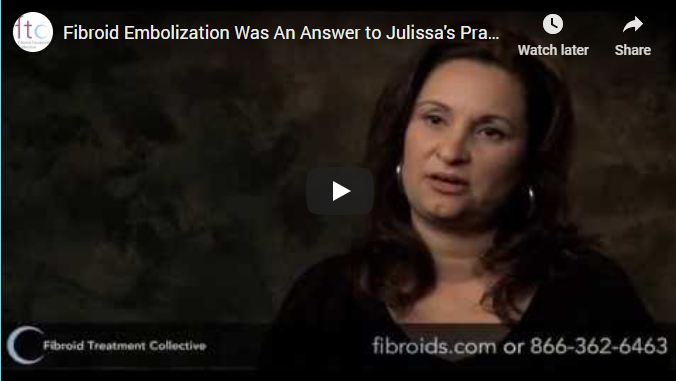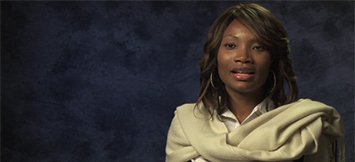You’ve been diagnosed with fibroids. You’re considering treatment. Why not start by knowing all your options? Then compare each to your own treatment goals and expectations.
Diet & Nutrition
A low-fat, high-protein diet may help slow fibroid growth and relieve some symptoms. How? Certain substances secreted by fat cells mimic the effects of estrogen. Estrogen is linked to the development fibroids and fibroid growth. By limiting fat in your diet, you reduce fat cells and their ability to mimic estrogen. The high-protein part of this diet can be challenging. Protein sources such as factory-farmed eggs, dairy, meat, poultry and fish often have high levels of estrogen. Many plant-based proteins such as soy products, beans, nuts and yams are also estrogen rich.
Benefits & Drawbacks
No medication or surgery is required. There are overall health benefits to reducing fat and increasing protein in your diet. Still, most people find restrictive diets difficult to maintain. And estrogen is common in many foods. The amount of estrogen you can actually regulate through dietary changes may have little or no impact on fibroid symptoms.
Hormone Therapy
Female sex hormones play an important role in fibroid growth. Certain hormones and hormone combinations can be used to reduce fibroid symptoms such as heavy bleeding and period pain. Hormone therapy will not eliminate or ‘cure’ fibroids. It can only be prescribed for a limited amount of time, due to the risk of side effects.
Androgen Therapy/Danazol
Danazol, a synthetic drug similar to testosterone, can stop menstruation, correct fibroid-related anemia and reduce fibroid and uterine size.
Progestin-Only Birth Control Pills & IUDs
Progestin is a synthetic steroid hormone that helps regulate the menstrual cycle by inhibiting the amount of uterine lining shed during menstruation. Progestin-only pills or IUDs are most suitable for women whose main symptom involve heavy periods.
Combination Birth Control Pills
Low levels of progestin and estrogen work in combination to decrease menstrual flow and reduce uterine cramping. Uninterrupted use of the combination birth control pill can cause menstrual periods to stop completely over time.
Gonadotropin-Releasing Hormone (Gn-RH) Agonists
The natural gonadotropin-releasing hormones in your body stimulate the ovaries to produce estrogen and progesterone. Sythnetic agonists like Lupron and Synarel have the opposite effect. Treatment with these drugs causes estrogen and progesterone levels to drop. Fibroids shrink in response, temporarily reducing fibroid-related symptoms.
Benefits & Drawbacks
Hormone therapy can provide symptom relief for heavy or painful periods. Some hormones may also shrink fibroid and uterine size. But hormone therapy can only offer temporary relief. And side effects range from minor changesin mood and energy level, to weight gain, acne, unwanted hair growth, anxiety and hot flashes.
Hysterectomy
A surgery to completely remove the uterus. At one time, hysterectomy was the most commonly prescribed treatment for women experiencing pain, excessive bleeding or other debilitating fibroid symptoms. Is major surgery to remove a major organ actually necessary? More and more patients question its appropriateness.
Hysterectomy Surgery Falls Into 2 Categories:
Abdominal Hysterectomy
This is the most common type. About 65% of all hysterectomies will be an open surgery, using a 5 to 7 inch incision to cut through the tissue and muscles of the abdominal wall. The surgeon removes the uterus through this incision, then closes it with staples and/or sutures. Patients spend 2 to 5 days in the hospital. Recovery is long, as cut tissue and muscles require time to knit and heal. Pain level depends on the patient, but generally speaking, this is major surgery and pain management is required. There will be a large and visible scar at the location of the incision.
Laparscopic Hysterectomy
A less invasive form of hysterectomy. Instead of one large, open incision, the surgeon removes the uterus through small incisions in the belly (laparoscopic hysterectomy) or through an incision in the vagina (laparscopic-assisted vaginal hysterectomy). Laporascopic hysterectomy involves a device called a laparscope; a tube that introduces a lighted camera and surgical tools to the body’s interior. The surgeon views what the camera sees on a video screen, then uses the surgical tools to remove the uterus. A newer form of laparoscopic hysterectomy (called robot-assisted) pairs the surgeon with automated surgical tools and a three-dimensional viewing screen. Laparscopic hysterectomies use smaller incision sites, so healing time and scarring are reduced.
Benefits & Drawbacks
A hysterectomy eliminates fibroids. (No uterus, no uterine fibroids.) But hysterectomy is major surgery and like all surgeries, has potential risks and complications. Yes, a hysterectomy ends a fibroid problem. But also menstrual periods and the ability to conceive, carry or deliver a baby. For some women, this is acceptable. For others, removing a significant female organ is not the first choice in treatment.
Myomectomy
A procedure that surgically removes fibroids, but leaves the uterus intact. Myomectomies are often offered to women of childbearing age who wish to keep that option open. Women who undergo myomectomy report improvement in fibroid symptoms, including heavy menstrual bleeding and pelvic pressure. But fibroids treated in this manner often re-grow. The younger you are and the more fibroids you have, the more likely you will be to experience fibroid-regrowth, after myomectomy. Uterine scarring from this surgery may also impair conception and complicate delivery.
Myomectomies Fall Into 3 Basic Categories:
Abdominal Myomectomy
An open incision, major surgery, using a 4 to 5 inch cut at the bikini line (just above the pubic area). Abdominal and uterine muscles are sliced to allow access to the fibroids, then stitched back together after fibroid removal. Blood loss during this surgery is common, so a blood transfusion may be required. Hospital stay involves a minimum of 2 nights. Home recovery is generally 4 to 6 weeks. Uterine scars from the procedure may complicate conception. Should you become pregnant post-procedure, it’s likely your obstetrician will recommend Caesarean (C-section) to avoid issues with surgically-weakened uterine walls.
Laparoscopic Myomectomy
When fibroids are small, few in number and not deeply imbedded in the uterine wall, this type of myomectomy is often suggested. Four incisions, slightly over ½ inch long, are made in the belly button, bikini line and near the right and left hip. The abdominal cavity is inflated with carbon dioxide gas. A laparscope (a tube with a lighted camera) is guided through one of the incisions, allowing the surgeon to see ovaries, fallopian tubes and uterus. Surgical tools are introduced through the other incisions and used to remove fibroids. After fibroids are removed, the gas is released, the uterine wall is stitched and the incisions are closed. A hospital stay is required and recovery is roughly 2 to 4 weeks.
Hysteroscopic Myomectomy
This is an out-patient procedure (no hospital stay) that is only performed to treat submucosal fibroids. Submucosal fibroids grow directly out from the uterine wall and into the uterine cavity, like a fetus. Hysteroscopic myomectomy is not suitable for intramural fibroids (fibroids fully inside the uterine wall) or subserosal fibroids (inside the uterine wall and growing away from the uterine cavity). Hysteroscopic myomectomy is similar to a D & C (dilation & curetage). A speculum opens the vagina and instruments are guided past the cervix and into the uterus. Fluid is used to expand the uterus and any visible fibroids are scraped off the uterine wall. Post-procedure, you will be under observation for a few hours. Recovery takes a few days.
Benefits & Drawbacks
Myomectomy leaves the uterus intact. Menstruation and childbearing ability are preserved. But the possibility of fibroid regrowth is significant. 50% of all myomectomies need to be repeated. Your opportunity for pregnancy is limited by how quickly fibroids re-appear. Uterine scarring caused during surgery may hamper conception. Uterine walls weakened by myomectomy incisions may require a C-section during delivery.

Radio Frequency Ablation (RFA)
A non-surgical procedure that destroys fibroid tissue with high frequency energy. RFA utilizes a needle-like probe, inserted through a small abdominal incision. The probe is guided by laparscopic and ultrasound imaging, then inserted into each fibroid and activated. High energy radio waves “heat” tissue and impair its function. In response to this damage, fibroids begin to shrink.
Benefits & Drawbacks
Out-patient means no hospital stay and a minimal recovery time. Entry incisions are small and uterine tissue isn’t cut, removed or sutured. But this method of fibroid treatment is new and studies of its long-term efficacy are not yet available. The possibility of fibroid-regrowth is unknown. The procedure’s effect on fertility and childbearing has not been evaluated.
Uterine Fibroid Embolization (UFE)
Embolization is a medical term referring to the selective blocking of blood vessels. Embolization has been used for decades to stop bleeding or to inhibit blood supply in tumors. Uterine fibroid embolization utilizes both of these actions in treatment. UFE stops excessive menstrual bleeding immediately. And inhibits blood flow within the fibroid itself.
Without a blood supply, fibroids starve and shrink. Symptoms of pain, pressure and distended uterus end. UFE requires a single, small incision in the groin area which allows a thin, flexible catheter to introduce blocking agents to fibroid blood vessels. Only fibroid vessels are blocked. Blood supply to the rest of the uterus is not affected.
Benefits & Drawbacks
UFE is a simple, non-surgical treatment with a very quick recovery time. It offers immediate relief from excessive bleeding. Embolized fibroids cannot re-grow, because their blood supply has been eliminated. UFE does not disturb or damage uterine tissue. National and international studies indicate UFE does not impair fertility in patients of childbearing age. But there may be some post-procedure discomfort. Fibroid shrinkage can take up to six months. And most OB/GYNs aren’t certified to perform UFE, so patients are often referred to a radiologist.
Fibroids hurt Ingrid’s health and her sex life. Embolization freed her.
“It was very painful. So I could not enjoy myself. And he wasn’t enjoying himself with me.” Fibroids made intimacy unpleasant. They also kept Ingrid weak, anxious and dangerously anemic. One quick, non-surgical treatment turned her life around.





